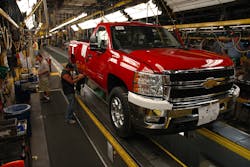Rolling back GHG light vehicle rules: what does it mean for trucking?
The hue and cry is already starting over an expected move by the Environmental Protection Agency (EPA) to “revise” light vehicle greenhouse gas (GHG) and fuel economy rules implemented during the Obama administration – even though that “move” hasn’t been made publicly yet.
Already, 12 states and the District of Columbia said they will sue the EPA if that “rollback” happens, while others are citing surveys and other research that those GHG standards actually save motorists money in the long run.
“The cost of meeting standards is likely being overstated by as much as 40% by the EPA,” according to a study by the International Council on Clean Transportation (ICCT). “Based on current technology and cost trends, ICCT finds even more stringent standards out to 2030 are feasible” from a cost benefit perspective, the group noted.
“The nation has seen increased investment in manufacturing and job creation driven by the implementation of world-leading fuel economy and GHG standards,” noted Zoe Lipman, director of vehicles and advanced transportation for the BlueGreen Alliance, in a separate statement.
“If the EPA opts to write new rules, we will be watching to see whether those rules remain strong and continue the current trajectory of innovation, investment, and job growth. Stepping away from fuel economy leadership would put key elements of the nation’s economic progress in jeopardy,” Lipman said.
Indeed, that group recently released a report entitled Driving Investment: How Fuel Efficiency is Rebuilding American Manufacturing tracking investment in the nation’s automotive plants over the past decade as automakers have implemented current fuel economy standards – illustrating how fuel economy standards “drive innovation and enhance manufacturing growth and shows how what are often described as the ‘costs’ of compliance with clean vehicle standards actually represent a multi-billion dollar reinvestment in American manufacturing and jobs nationwide.”
Specifically, that report claims:
- A total of $76 billion in new and promised investment in the nation’s automotive plants since 2008.
- S. automakers have invested $64 billion in facilities across the country, completing 258 investments at 100 factories.
- An additional $12 billion in investments in 37 facilities are underway or promised by 2020.
If the EPA plans to weaken standards, that would be fundamentally the wrong move. Rolling back strong national fuel economy and emissions standards will undermine the global competitiveness of the U.S. auto industry,” added Scott Stringer, the comptroller of New York City, investment advisor to — and custodian of — the $190 billion New York City Pension Funds, in a statement.
He stressed that New York is one of 13 states, plus the District of Columbia, that have adopted clean car standards that are in line with current national vehicle emissions and fuel economy standards
“In the absence of federal leadership, states need to continue to lead on clean car standards. That’s because an auto industry that doubles down on producing gas-guzzling cars is like making a bet on beepers in a smart-phone age. Fuel efficient vehicles are good for our environment – and good for business,” Stronger stressed.
“As shareholders in the biggest automotive companies – with nearly $200 million invested in Ford and General Motors alone – we can’t risk a slowdown in the pace of innovation that drives investment. Auto markets are increasingly global, and governments around the world are adopting standards that place a premium on clean, efficient, advanced vehicles,” he said. “If the EPA makes a short-sighted and backwards federal decision, as laboratories of innovation, the clean car states will continue to provide the signal automakers need to stay competitive and profitable.”
So, two questions: will those pronouncements lead to a protracted court battle aimed at maintaining the current GHG/fuel economy rules for light vehicles? And if that court battel is not successful – if the GHG/fuel economy rules for light vehicles get revised as planned – will EPA undertake a similar effort in the heavy truck arena, mirroring its efforts where glider kits are concerned?
Only time will tell. But it will "tell" pretty quickly, I am guessing.
About the Author
Sean Kilcarr
Editor in Chief
Sean Kilcarr is a former longtime FleetOwner senior editor who wrote for the publication from 2000 to 2018. He served as editor-in-chief from 2017 to 2018.
